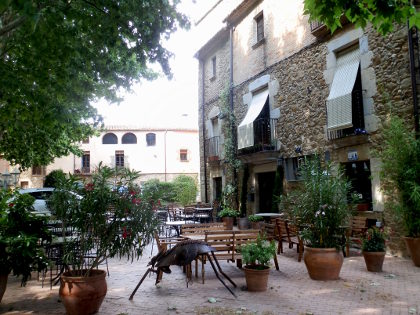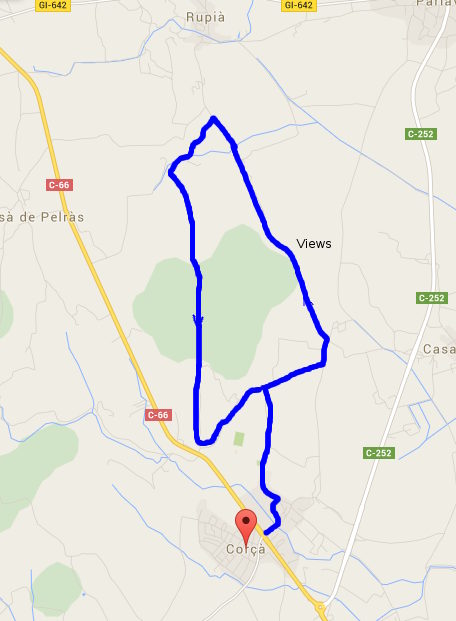Corça fields and views
 Corça is a little bit of a hidden gem situated just outside La Bisbal d'Emporda. This is the third or fourth walk from Corça for our blog, but it's still a super-charming village off the beaten track as far as tourism goes, with honey-stone houses, archways and nooks and crannies that wouldn't look out of place in the Cotswolds or the Dordogne. Yet it's so easy to miss. As is so common here, the main road, full of travellers rushing from Girona to the coast, skirts by leaving no impression of centre.
Corça is a little bit of a hidden gem situated just outside La Bisbal d'Emporda. This is the third or fourth walk from Corça for our blog, but it's still a super-charming village off the beaten track as far as tourism goes, with honey-stone houses, archways and nooks and crannies that wouldn't look out of place in the Cotswolds or the Dordogne. Yet it's so easy to miss. As is so common here, the main road, full of travellers rushing from Girona to the coast, skirts by leaving no impression of centre.
So we're back to fill in a little gap heading towards Rupia with views across the plain to the neighbouring villages and out towards the Isles Medes in the distance.
The entrance to the older part of the village is just off the main Bisbal-Girona road where from the rush of traffic on the main road, we emerge in a village placa shaded by plane trees with a children's playground just besides a small stream. There's some parking here, but we normally park just outside on the main road and walk in past the seemingly sunken cottages and school. The playground is buzzing with the noise of children and mum's but the small main bar is quiet and empty.
 We're mainly after the walk today so we skip the centre of the village and navigate along the lanes by the old village defensive wall crossing in and out of the old gate arches. At the top of the village we follow the sign towards the Camp de Futbol along a road of stone terrace cottages that look as if they could be twinned with Bibury. The road reaches a small chapel and we turn to the right up the road along a small track climbing gently.
We're mainly after the walk today so we skip the centre of the village and navigate along the lanes by the old village defensive wall crossing in and out of the old gate arches. At the top of the village we follow the sign towards the Camp de Futbol along a road of stone terrace cottages that look as if they could be twinned with Bibury. The road reaches a small chapel and we turn to the right up the road along a small track climbing gently.
The noise of music and a marquee tent tell us we're just passing a colonies house. In Spain, it's extremely common for schools to arrange visits to different parts of the country for casal or colonies with children staying in special centres - usually old farmhouses - in the country with a range of outdoor activities. In summer, with the long three-month holidays, many children get a week or two at the same colonies houses either just for the fun of it, or often taking part in sports, music or learning languages.
Our track continues upwards before turning right past an overgrown field with cows hiding among the bushes. If you're used to walking in England where every route seems to go through a field with cows, you have to appreciate that cows aren't that common by the coast - you see them more in the hills towards the Pyrenees - so it's a little surprising to see them here and hidden in amongst the shrubs.
The track turns to the left and we follow the signpost towards Rupia. From the hillside we can look out and see six or seven villages in the distance - small huddles of buildings nestled around the church - Ultramort, Casavells, Matajudaica closer to us and then further out to Llabia and the church of Palava standing tall. We also get to glimpse the Castell d'Emporda and in the distance we can see the estates of L'Estartit and the tops of the Islas Medes.
The wheat in the fields as we walk is not so dry that's it's almost magnolia in colour despite just being the first of June. The path though continues along the hedgerows towards Rupia, but rather than go to the village itself, we shorten the route past an equestrian centre before meeting the road we took on our last walk in this area.
As we get back to the village it's gone quiet. A dad and his son are racing through the empty streets, but the playground by the placa is empty as Corça goes back to being another sleepy hidden village.


 Walks and other things
Walks and other things